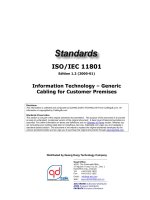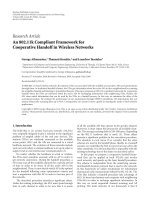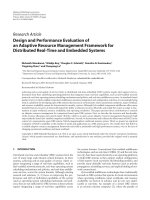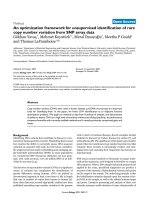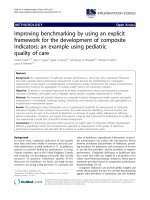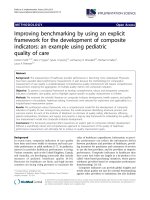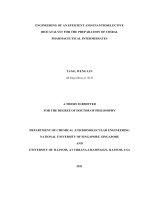Tailoring an information technology governance framework for national bank of ethiopia
Bạn đang xem bản rút gọn của tài liệu. Xem và tải ngay bản đầy đủ của tài liệu tại đây (2.26 MB, 124 trang )
ADDIS ABABA UNIVERSITY
COLLEGE OF NATURAL AND COMPUTATIONAL SCIENCES
SCHOOL OF INFORMATION SCIENCE
TAILORING AN INFORMATION TECHNOLOGY GOVERNANCE
FRAMEWORK FOR NATIONAL BANK OF ETHIOPIA
By
TEMESGEN ASNAKE
JUNE, 2017
ADDIS ABABA, ETHIOPIA
ADDIS ABABA UNIVERSITY
COLLEGE OF NATURAL AND COMPUTATIONAL SCIENCE
SCHOOL OF INFORMATION SCIENCE
TAILORING AN INFORMATION TECHNOLOGY GOVERNANCE
FRAMEWORK FOR NATIONAL BANK OF ETHIOPIA
A Thesis Submitted to School of Graduate Studies of Addis Ababa University in
Partial Fulfillment of the Requirements for the Degree of
Master of Science in Information Science
By: Temesgen Asnake
Advisor: Lemma Lessa (PhD)
June, 2017
Addis Ababa, Ethiopia
ADDIS ABABA UNIVERSITY
COLLEGE OF NATURAL AND COMPUTATIONAL SCIENCE
SCHOOL OF INFORMATION SCIENCE
TAILORING AN INFORMATION TECHNOLOGY GOVERNANCE
FRAMEWORK FOR NATIONAL BANK OF ETHIOPIA
By: Temesgen Asnake
Name and signature of Members of the Examining Board
Lemma Lessa (PhD)
__________
_________
Advisor
Signature
Date
Temtim Assefa(PhD)
__________
_________
Examiner
Signature
Date
Getachew Hailemariam(PhD)
__________
_________
Examiner
Signature
Date
Declaration
This thesis has not previously been accepted in substance for any degree and is not being concurrently
submitted in candidature for any degree in any university. This thesis is the result of my own
investigations, except where otherwise stated. Other sources are acknowledged by citations giving
explicit references. A list of references is appended.
Signature: ________________________
Temesgen Asnake
This thesis has been submitted for examination with my approval as university advisor.
Advisor’s Signature: ________________________
Lemma Lessa (PhD)
I
Acknowledgements
What I’m sure is, I cannot finalize this work, if I haven’t met Dr. Lemma Lessa in my life as my thesis
advisor. I am deeply grateful to my advisor, for his precious comments, guidance and unreserved
support in checking and giving constructive suggestions. He was not only my advisor of this research
work but also all rounded life advices triggered me to invest my maximum effort to this work and I
would like to say thank you!
I would like to thank my close friend and workmate ato Eyasu Teshome that always push and remind
me to continue and finalize on all the work steps of this thesis and in the entire MSC program as well.
I would also like to thank my officemates ato Waktola Merdassa ,ato Seife Hailu, ato Biruk Mengistu
and all others that support me during this thesis work process and data collection and analysis process
as well. There is also a Special Thanks to Ato Tagel Mekonen that assisted and permits me for data
collection instrument preparation and formatting.
Finally, I would like to thank both my classmates as well as the community of school of information
science graduate studies of Addis Ababa University for their support in the journey.
Temesgen Asnake
June, 2017
Addis Ababa
II
Abstract
Managing IT and its resources is very difficult and being a big IS research areas at this time. National
bank of Ethiopia is the Central bank of Ethiopia that is responsible for monetary policy. Over the years,
organizations become highly dependent on IT to the point where it would be impossible for them to
function without it. IT governance (ITG) is defined as the processes and practices that ensure the
effective and efficient use of IT in enabling an organization to achieve its goals. There are a number of
IT governance standards or frameworks available but extant literature reveal that direct adoption of an
IT governance framework is bulky and very difficult since all organizations are context-dependent.
The objective of this research is to propose a tailored IT Governance framework for National bank of
Ethiopia. There are number of challenges during directly applying or adapting any IT governance
framework and there is a need of tailoring to the specific organization since all organizations in the
world are context-dependent that are affected by their internal and external environment.
The research then utilized the Delphi Method with two rounds to gather opinion from NBE experts on
COBIT5 Items to come to consensus on how to consume those Items to NBE. To answer all the
research questions the research uses thirty elements of COBIT5 (from five principles and seven
enablers).
As key findings of this research, there are four COBIT5 framework elements which were removed,
namely Implemented IT governance Framework or some standards, Collection of competitive products
and services, separated IT Governance and management and the last one is IT Governance is expected
to cover all Enterprise issues (All Covered). The others list from 1st up to 26th show the ranked list of
items for implementation and COBIT5 usage from higher need to lower need based on NBE’s current
context and environment readiness. Finally proposed framework is established based on the experts’
consensus on the elements which were already sorted. Then, possible recommendations are forwarded
for future action in short and long terms by key stakeholders.
III
Keywords:IT governance, COBIT5,IT governance framework, Tailoring, IT Governance Feature
Elements.
IV
Table of Contents
Declaration ..................................................................................................................................................I
Acknowledgements ................................................................................................................................... II
Abstract .................................................................................................................................................... III
List of Tables ........................................................................................................................................ VIII
List of Figures ..........................................................................................................................................IX
List of Acronyms ...................................................................................................................................... X
CHAPTER ONE ........................................................................................................................................ 1
INTRODUCTION ..................................................................................................................................... 1
1.1
Background ................................................................................................................................. 1
1.2.
Statements of the problem ........................................................................................................... 4
1.3.
The research questions ................................................................................................................ 7
1.4.
Objective of the study ................................................................................................................. 7
1.5.
Significance of the study ............................................................................................................. 7
1.6.
Scope of the study ....................................................................................................................... 8
1.7.
Ethical Concerns ......................................................................................................................... 9
CHAPTER TWO ..................................................................................................................................... 10
LITERATURE REIVEW ........................................................................................................................ 10
2.1.
Governance: Overview .............................................................................................................. 10
2.1.1.
Enterprise Governance .......................................................................................................... 11
2.1.2.
Corporate governance ............................................................................................................ 11
2.1.3.
IT Governance ....................................................................................................................... 12
2.2.
Evolution of IT governance....................................................................................................... 12
2.3.
IT Governance vs. IT Management........................................................................................... 13
2.4.
Importance of IT Governance ................................................................................................... 15
2.5.
Focus areas of IT Governance ................................................................................................... 16
2.6.
IT Governance frameworks ....................................................................................................... 17
2.6.1.
Control Objective for Information and related Technologies (COBIT) ................................ 19
2.6.2.
The IT Infrastructure Library (ITIL) ..................................................................................... 21
2.6.3.
ISO17799/27000 .................................................................................................................... 21
2.8.
The reason to contextualize the IT governance framework to the specific organization. ......... 23
2.8.1.
A drawback of available frameworks, if used as it is. ....................................................... 23
2.8.2. Tailoring or adapting process of IT governance frameworks for particular organization’s
context. 25
V
3.
Chapter Summary ............................................................................................................................ 25
CHAPTER THREE ................................................................................................................................. 27
RESEARCH METHODS AND DESIGN ............................................................................................... 27
3.1.
Introduction ............................................................................................................................... 27
3.2.
The Research Approach ............................................................................................................ 27
3.3.
The Delphi Method Description................................................................................................ 29
3.3.1.
Background ........................................................................................................................ 29
3.3.2.
Relevancy........................................................................................................................... 30
3.3.3.
How to apply the Delphi Method....................................................................................... 30
3.4.
The Research Design ................................................................................................................. 31
3.4.1.
Sampling ............................................................................................................................ 32
3.4.2.
Instruments ............................................................................................................................ 32
3.4.3.
Variables ................................................................................................................................ 33
3.4.4.
Evaluation Mechanism .......................................................................................................... 33
3.4.5.
Procedure ............................................................................................................................... 34
3.4.6.
Data analysis .......................................................................................................................... 34
3.4.7.
Study setting....................................................................................................................... 34
3.4.8.
Target population and sampling methods .......................................................................... 34
3.4.9.
Method of data collection, Instrument development and validation.................................. 36
3.5.
COBIT5 Basic Control Elements Establishment for Tailoring or Contextualizing .................. 38
3.6. Assess COBIT5 Control Elements In Relation to NBE Context and Identify Gaps From the
Basic Established Controls and Forward to Consensus Result. ........................................................... 39
3.7.
Chapter Summary...................................................................................................................... 41
CHAPTER FOUR .................................................................................................................................... 42
DATA PRESENTATION AND INTERPRETATION ........................................................................... 42
4.1.
Introduction ............................................................................................................................... 42
4.2.
Demographic Data Presentation ................................................................................................ 43
4.3.
COBIT5 Feature Elements that are selected as a Candidate for tailoring presentation ............. 45
4.4.
Important List of COBIT5 Features to NBE in the Future (list by importance) ........................ 53
4.5.
Level of fit of COBIT5 features to NBE Context? .................................................................... 58
4.6. Combined or cumulative sorting by the three sorting outputs (Candidate, Importance and Fit
level) 64
4.7.
Round two data representation .................................................................................................. 67
4.8.
Proposed Framework................................................................................................................. 73
VI
4.9.
4.10.
Discussion ................................................................................................................................. 79
Chapter summary................................................................................................................... 80
CHAPTER FIVE ..................................................................................................................................... 82
CONCLUSION AND RECOMMENDATION ....................................................................................... 82
6.
5.1.
Introduction ............................................................................................................................... 82
5.2.
Summary of the key findings .................................................................................................... 82
5.3.
Conclusion................................................................................................................................. 83
5.4.
Limitations of the study............................................................................................................. 84
5.5.
Recommendations ..................................................................................................................... 84
5.6.
Future research directions ......................................................................................................... 85
REFERENCES ................................................................................................................................ 87
Appendix A: Survey Questionnaire-Round One ................................................................................. 90
Appendix B: Survey Questionnaire-Round Two ............................................................................... 100
VII
List of Tables
Table 1 Respondents’ demography-Gender ........................................................................................... 44
Table 2 Respondents’ demography-Age ................................................................................................ 44
Table 3 Respondents’ demography-Education ...................................................................................... 45
Table 4 Respondents’ demography-ITG Training ................................................................................ 45
Table 5 The Given List of COBIT5Elements (list of five principles and seven Enablers) ...............Error!
Bookmark not defined.
Table 6Sorted list of 30 Items for candidate selection from more accepted to tailor to less accept to
tailor ................................................................................................................................................ 52
Table 7Sorted list of 30 Items for the importance list of Items .............................................................. 58
Table 8Sorted list of 30 Items for the Fit level (extent of fit) list of Items .............................................. 64
Table 9Sorted list of 30 Items for the Fit level (extent of fit) list of Items . ............................................ 67
Table 10Sorted list of thirty Items from round one . ............................................................................... 68
Table 11Sorted list of 30 Items for candidate selection from more accepted to tailor to less accept to
tailor ................................................................................................................................................. 72
VIII
List of Figures
Figure 1 Governance Hierarchy in an enterprise (Sallé, 2004) ............... Error! Bookmark not defined.
Figure 2 Evolution stage of IT Governance from Sallé (2004) ............................................................... 13
Figure 3 IT governance and IT management (Petar, 2011) ..................................................................... 14
Figure 4 IT governance Coverage areas ITGI (2006) Broad Briefing of IT governance ....................... 17
Figure 5 Corporate Governance and IT governance systems (Leonardo, 2008) .................................... 18
Figure 6COBIT framework (ITGI, 2006) ................................................................................................ 20
Figure 7 COBIT Core Concepts (Zhang, 2013)...................................... Error! Bookmark not defined.
Figure 8IT governance framework (proposed by Leonardo Caporarello, 2008)Error! Bookmark not
defined.
Figure 9 Delphi method Phases overview. ............................................................................................ 37
Figure 10A complete business framework for the Governance of Enterprise IT .................................... 39
Figure 11ISACA’s COBIT5Principles .................................................................................................... 40
Figure 12 COBIT5 Principles ................................................................. Error! Bookmark not defined.
Figure 13COBIT5 Governance and Management Key areas .................. Error! Bookmark not defined.
Figure 14 List of Candidates of COBIT to be tailored to NBE ............................................................... 48
Figure 15 List of COBIT5 Items with Importance level to NBE ............................................................. 54
Figure 16 List of COBIT5 Items with Extent of fit level to NBE environment ....................................... 60
Figure 17 List of COBIT5 Items with Extent of fit level to NBE environment ...................................... 65
Figure 18 List of COBIT5 Items for second Round -sorted .................................................................... 69
Figure 19 Proposed Framework-COBIT5 Enablers Perspective .............................................................. 77
Figure 20 Proposed Framework-COBIT5 Principle Perspective ............................................................. 78
IX
List of Acronyms
NBE
National Bank of Ethiopia
COBIT5
Control Objectives for Information and Related Technologies- version 5
ITG
Information Technology Governance
ITIL
Information Technology Infrastructure library
IS
Information System
CIO
Chief Information officer
X
CHAPTER ONE
INTRODUCTION
1.1 Background
The shift from technological centric organizations to service providers’ makes the change that the
management of IT is looked from the newer perspectives (Yousif & Hidayah, 2015).Banks are a
very critical sector of a nation’s economy. As a traditional concept, banks ensure the transmission of
funds from surplus to deficit units and serve the society who need additional fund. They also
facilitate spending and investment, which fuel growth in the economy(Eden, 2014).Pervasive use of
technology in banks and other sectors has created critical dependency on IT that calls for a specific
focus on IT Governance (Tagel, 2016).
Today Information Technology (IT) can be found in every modern enterprise. Since, IT has become
one of the most critical parts of an enterprise, it has made management aware of the impact IT has on
the success of the enterprise. It also significantly increases on IT investments. IT governance aims at
assuring that IT delivers more value from IT investments and enforcing IT’s role as a business
enabler (Eden, 2014).According to Saiqa & Nabeel(2012) recently, alignment between information
technology and corporate governance is creating a new research area.
Today, IT governance is on the main agenda of many organizations, and high-level IT governance
models are being created(Said & Alami, 2014). Even though, any governance model is developed it
doesn’t mean this high level model imply that governance is actually working in the organization.
Conceiving the IT governance model is the first step, implementing it into the organization as a
sustainable solution is the next challenging step (Haes & Grembergen). National Bank of Ethiopia
which is the central bank of Ethiopia is also one of the most crucial financial service providers in the
country. Since the bank’s role is monetary stability and a regulatory body for the entire economic
activity, its services are enabled by information technology operations. The question of IT
governance is raised here with a level of that will have a vast impact on all financial services
delivery. The question is how organizations can pragmatically implement a sustainable IT
1
governance framework. As proposed by Peterson et al. (2004), IT governance can be deployed using
a mix of structures, processes and relational mechanisms.
The term “IT Governance” first appeared in academic literature in the early 1990s, but was not
addressed directly until later that decade, with the introduction of specific IT governance studies
such as (Brown,1997). Also marking the prominence of this period was the foundation of the IT
Governance Institute (ITGI) in 1998 (HaesandGrembergen, 2005), an industry organization
established to build and foster a practitioner-focused understanding of the IT governance notion.
(Gerald and Allen, 2007).Governance is the single most important factor in generating value from
IT, and it is a critical success factor for the organization. (Governance, 2013).
Despite the formalized recognition and use of the IT governance term, the understanding of how
organizations structured, monitored and evaluated their IT functions has been long studied, but under
such labels as control of IS services (Olson and Chervany, 1980), IS organizational structure
(Simson, 1990), IT decision making responsibilities (Boynton et al. 1992), and IS organizational
roles (Brown and Magill, 1994). The multiplicity and diversity of IT governance research has led to
a variety of definitions of IT governance being put forward over the years (Haes andGrembergen
2005; Webb, et al., 2006). However, still there is not sufficient consensus on an accepted definition.
Drawing on the literature, we understand IT governance to be a dynamic, performance driven,
adaptive, relational process of aligning corporate and IT strategies, objectives, accountability
structures, systems, and practices with the objective of delivering valuable, risk-reduced, and
measurable returns on IT-related investments (Gerald,et al, 2007).
Initial research into IT governance was widely based on understanding the structural and physical
arrangements of the IT function within the overall context of an organization. Concerned primarily
with defining the locus of IT control, most early studies were focused on the basic bipolar model of
centralized and decentralized structures, with the objective of determining the relative merits of one
of these governance forms over the other (for example, Golub 1975, Keen 1981, Olson and
Chervany 1980).Upon reaching a theoretical saturation of this basic notion, practitioners and
2
academics turned to investigating novel governance forms that represented horizontal and vertical
expansions of this baseline dichotomy (Brown and Grant 2005).
Simultaneous to the development of new governance structures, a separate body of research
investigated how best to choose from the ever-growing pool of IT governance models. Primarily
oriented towards contingency analysis, the goal of this stream of research was to provide generalized
alignment Selection criteria for organizational decision makers, who at this point, were starting to be
overwhelmed by the plethora of available options (Gerald et al, 2007).
Researchers were examining and addressing the fundamental concepts of IT governance even as
early as the 1960‟s, but it was not until the late 1990‟s that the notation of Information
system(IS)governance frameworks and then later IT governance frameworks started to feature
prominently in the academic literature (Mengistu, 2015).
Information Technology (IT) governance is considered as one of the critical success or failure
factors for organizations that are IT dependent for information provision and business
operations(Chris & Charles, 2015).Because of the pervasiveness and dependence on information
technology (IT) in organizations, the importance of an alignment between IT units and the business‟
strategic direction has increased. This alignment is the primary goal of IT Governance (Mengistu,
2015).
Good IT governance is about providing processes and decision-making structures for the business so
it can make reasoned decisions on IT matters. It also describes how well IT activities are
implemented, how effectively the resources are being used and how well the effectiveness of the
implementation of the activities is measured (Green, 2001).Due to the dynamic and highly
competitive business environment nowadays where firms spend around 3-5 percent of their revenues
each year on IT just to stay competitive, good IT governance is no longer nice to have but it is a
must have (Donald, 2015)
In this study, the question of IT governance related to its business need achievement and critical
dimensions or impact to the economy in relation to IT services will be addressed in national bank of
3
Ethiopia as a central bank on which all banks services are dependent on this bank’s IT series
delivery.
1.2. Statements of the problem
Since, there is no overall, universal best governance framework, and that each organization must
implement a mix of these different requirements in a manner most appropriate to their environment
(Gerald et al, 2007).According to Simms (2008), failure to govern IT adequately can result in
insufficient financial return of IT investments, large financial losses, and an increased risk profile of
the organization. The current financial crisis has shown that failing governance implementations
affect organizations and economy (Christoph et al, 2009). The failure impact on central banks, at
national bank of Ethiopia is not only limited to the organization itself, propagated to the entire
financial sector. Although a significant amount of work has been done on the subject of IT
governance , still they appears to be some disjointed and confusion about what IT governance really
is and how it may be realized in practice (Gerald et al, 2007).
Number of questions raised within IT Governance have been identified and warrant further
investigation. They range from the empirical research necessary to support the presented IT
Governance arrangements, to the linkage of corporate and IT Governance and the design choices of
organizations within that context, to how organizations need to implement IT Governance to balance
IT value delivery and IT risks (Governance, 2013).
The presented conceptual map of IT Governance components needs to be tested and supported by
empirical evidence (Christoph et al, 2009). It depends contextually to specific organization like NBE
since corporate governance and IT governance are feeding each other.
Central banks were originally established with the purpose of providing the banking sector with
finality, which is essential for the smooth and stable functioning of payment and settlement systems
operated by the private banking sector. In this sense, the banking sector and central bank collaborate
by providing payment and settlement systems, in which bank notes and bank deposits are used as
means of payment (Kazuhiko, 2014).
4
Mapping organization nature to the proper IT governance model is not simple; these include
duplication of resources, difficulty in achieving institution wide alignment with strategic business
objectives, and IT risks that were not being managed (Said & Alami, 2014). As a consequence, these
institutions were in various stages of review and subsequent implementation of comprehensive IT
governance restructures (Michael, Graham, & Brian, 2012).
NBE may use the world’s available IT governance frame works, but these IT governance methods
and tools are considered too heavy, inflexible and thus expensive to implement (Chadi, Savanid&
Yang, 2011). Recent fast advancements in technology require new agile or adaptive ways of
working. Hoogervorst noted that the changes in the technology are leading new ways of working
such as self-management and self-organization. These emerging trends are significantly changing the
IT landscape by challenging the boundaries and traditional ways of working. There is a need to
understand the concepts of Enterprise IT governance (EIT) in the modern context of emerging
technologies and trends (Muhammad & Gill, 2007). NBE also moving the way forward on those
new technology implementations and fail in dynamic IT administration that need a FIT IT
governance framework framed to NBE context. As much as more dynamic picture is likely to
emerge as IT governance in a context that both enables and constrains action. Similarly (Jennifer &
McKay, 2012)propose that institutional pressures play a role in determining the IT governance
mode.
Extended governance model done by (Gerald, Allen, Aareni, & Shawn, 2007) is not answering
issues like final tailored or fittest framework for specific organization. A paper by Said & Alami(
2014) trying to compare most IT governance framworks but don’t describe about how to tailoring to
specific organization.
The IT Governance framework of Dahlberg and Kivijärvi aims to support the use of COBIT or ITIL
by facilitating an executive level holistic IT governance review. This leads to the realization that the
framework is not detailed enough for implementation guidance. All processes of IT are covered.
This is the only framework that explicitly structures IT Governance from a lifecycle perspective only
5
(planning, operating, and evaluation) and presents the according processes (Christoph, Sharm, &
Dan, 2009).which lacks the Audit nature of COBIT5.
As the IT Governance arrangements implementation is dependent on the organization’s goals, which
vary across organizations, a selection of a preferred framework is difficult. Of the presented
frameworks, the COBIT framework is most frequently used and seen as the defacto standard of IT
Governance (Said & Alami, 2014). With the broad scope of covering all IT processes and explicit
guidance on its implementation, many professionals in the field of IT Governance use the framework
as guidance. It is important to implement explicit structures and processes together with implicit
coordination mechanisms to achieve effective IT Governance (Christoph, Sharm, & Dan, 2009).
Business is getting only more IT intensive, and IT is getting more complex. Maximizing value from
IT investments has always been an imperative for business. From the experience, more than 50% of
today’s IT investments are wasted or fail to deliver returns to the business. With the increase in
complexity, the cost of IT failure has become all the more significant (Richard, Greg, & Ziad).
Few studies can be mentioned in IT governances like Tagel Mekonin who suggested that, financial
institutions have to start implementing formal IT Governance which fits to their business strategy
and culture by mixing-and-matching elements of existing frameworks. But he was not putting a
framework for the IT governance for any of the financial institutions besides he tried to address the
maturity level of the financial sector in Ethiopia and indicating it is still in the lower level of
maturity.
The National Bank of Ethiopia (NBE) has implemented a number of projects like core banking
system, payment systems, credit bureau system, the coming applications including the new
datacenter construction which are central systems with highly integrations and different financial
operations like Ethiopian switch. Using those systems all financial institutions are regulated and
managed. NBE doesn’t have an implemented framework that will permanently address the failure in
IT systems and the finical sector as entirely.
6
1.3. The research questions
The main research question of this research is “What are those IT Governance Framework elements
which can be candidates to be tailored to NBE?”
This research paper will answer the following sub research questions.
•
What IT Governance framework elements are relevant to NBE?
•
What COBIT5 control elements are tailored to NBE environment?
1.4. Objective of the study
The general objective of the research is to propose a generic tailored IT Governance framework for
National bank of Ethiopia as a central bank for its efficiency and effectiveness to the whole financial
sector development through IT services and analyze how IT governance carried out in National bank
of Ethiopia which is responsible for monetary stability of the country.
Specific objectives:
•
To assess literature on previously related works for conceptual understanding and
to identify different framework elements and contextual items for NBE.
•
To assess available IT governance frameworks and to select one then to capture
its feature for tailoring.
•
To assess the IT governance framework tailoring steps
•
To propose proper contextual fit framework to NBE.
1.5. Significance of the study
The significance of this research is to consume the benefits that will be gained from the proposed
framework for NBE environment. Both the NBE IT professionals and management will use this
framework that helps them to deliver effective and efficient IT services to the bank and to the
financial sector.
The financial sector regulatory body like NBE which is the leader of the entire economic activity and
country’s development, its operation to achieve the above mission should be supported by the
information technology with high availability, secure, reliable and best performance to provide the
7
service to the sector effectively. To achieve this, the IT unit is highly important and be in “IT
governance Framework” as a central bank. Therefore, the purpose of the study is to propose the IT
Governance framework which is tailored after assessed from COBIT5 that will be contextualized to
NBE situations and missions.
1.6. Scope of the study
8
This research centers on IT governance frameworks, in particular COBIT5 based on the selection
criteria collected from literature, specifically in NBE. It also considers the Delphi rounds to process the
tailoring
From this research paper tailored and fit framework expected. Based on the previous works on the IT
governance frame works like (Saiqa & Nabeel, 2012); (Gerald et al, 2007); (Vargas, 2010) tailoring the
framework is a continuous research activity which is elaborated on this research paper. Tailoring and
contextualization of the framework elements or features are progressively shown on the research
process.
The research data collection was limited to a small portion of respondents; fifteen members with
purposive sampling were selected since expert opinion is needed specifically by the Delphi process.
1.7. Ethical Concerns
In this research CIOs from different domain areas like from infrastructure, applications, databases,
security, user support, knowledge management, research and project management are communicated,
will be observed and questionnaires will be distributed. The director and the higher officials also will
be the part of the research communications. At this time the privacy, legal and confidential matters will
be respected by the researcher since those individuals are managing a number of public and private
sector financial activities and regulations as a central bank.
9
CHAPTER TWO
LITERATURE REIVEW
This chapter is organized with the intension of developing concept construction to the IT Governance
frameworks adaption as well as tailoring process to achieve a contextual framework to the specific
organization like National Bank of Ethiopia. The content of the literature is organized as follows:
Governance Overview, IT governance, its evolution, the focus areas it covers, Development of IT
governance, it’s necessary elements with referring in the case of national bank of Ethiopia, It
governance frameworks with their drawbacks and problem domain during the implementations and
adaptations, how to tailoring those available frameworks to the given organization contexts as well. In
this part we will discuss in detail what IT Governance is and what is its current position in the
information technology era of this time.
2.1. Governance: Overview
Different literature can explain the word governance in a variety of ways since different authors using
this word for a variety of purposes in a number of disciplines for a variety of contexts as well. (Chadi,
Savanid, & Yang, 2011)
Numbers of definitions are available for the word governance with the context of the workable
definition of the given discipline. According to Governance (2013) as a workable definition
Governance is the process of establish chains of responsibility, authority, and communication (decision
rights) and establishing measurement, policy, standards and control mechanisms to enable people to
carry out their role and responsibilities. Before we come to this paper’s concern which is called ‘IT
governance’ let’s discuss about various governance types and issues in detail below.
10
2.1.1. Enterprise Governance
Information system audit and control Foundation and defines Enterprise Governance as: The set of
responsibilities and practices exercised by the board and executive management with the goal of
providing strategic direction ,ensuring that objectives are achieved ,ascertaining that risks are managed
appropriately and verifying that the organization’s resources are used responsibly (ISACA,2012).
According to Muhammad & Gill (2007) IT Governance is an integral part of enterprise governance and
consists of the leadership and organizational structures and processes that ensure that the organization’s
IT sustains and extends the organization’s strategies and objectives.
2.1.2. Corporate governance
From the relative definition of IT governance, corporate governance is the relationship between
corporate managers, directors and the providers of equity, people and institutions who save and invest
their capital to earn a return. It ensures that the board of directors is accountable for the pursuit of
corporate objectives and that the corporation itself conforms to the law and regulations (Haes &
Grembergen).According to Leonardo (2008), IT governance reflects the broader corporate governance
principles.
This can be explained by various theories or models of corporate governance Such as:
➢ Agency Theory (top management acting as agent for shareholders),
➢ Stewardship Model (top managers acting as good stewards of the corporations), and
➢ Stakeholder Model -the firm as a system of stakeholders operating within the larger system of
the host society that provides the necessary legal and market infrastructure(Donald and
Mengistu, 2015)
As (Chris & Charles, 2015) shows that, Business governance is a process, organizational function, set
of techniques, and systematic approach for creating and deploying policy and business rules into dayto-day business operations.
11
2.1.3. IT Governance
Since it includes several critical aspects, namely, leadership, organization and decision rights, scalable
processes and enabling technologies, IT governance is considered a complex system (Omari, 2016).
According to Petar (2011) the way enterprises govern their Information Technology (IT) is referred to
as IT Governance. We do have number of definitions for IT governance; however there is no single
universally agreed definition of IT Governance; different authors and institutions defined IT
Governance differently. Weill(2004) defined IT Governance as: “Specifying the decision rights and
accountability framework to encourage desirable behavior in the use of IT ”. IT Governance is not
about what specific decisions are made rather it is about systematically determining who makes what
decision (decision right), who has input right to the decision, and make sure that decisions are carried
out in the appropriate manner (measure and monitor the result) (Tagel, 2016).Many other articles in the
IT literature discusses and theorize the concept of IT governance, using different lens of analysis such
as business and IT alignment (Leonardo, 2008)
The term ‘governance’ in IT has been used to broadly describe the policies, structures, and management
processes involved in managing IT functions (Donald and Mengistu, 2015). IT governance is a subset
of enterprise governance whereby IT resources and process are managed (Senait, 2011). According to
ISO/IEC 38500 (2008) “Corporate Governance of IT is the system by which the current and future use
of IT is directed and controlled. Corporate governance of IT involves evaluating and directing the use
of IT to support the organization and monitoring this use to achieve plans. It includes the strategy and
policies for using IT within an organization”.
2.2. Evolution of IT governance
Historically IT grows continuously over a night and over the years, organizations becomes highly
dependent on IT to the point where it would be impossible for them to function without it. As a result
the role of IT in the enterprise changed from technology provider to strategic business partner.
According to Sallé (2004) IT has passed through three stages (see Figure 1). In the earliest stage IT
organizations focus on effective management of enterprise IT infrastructure. Next to Information
Technology Infrustructure Management (ITIM), IT organizations focus on identification and delivery
of quality IT services at a reasonable time and cost to both internal and external customers. When IT
12
